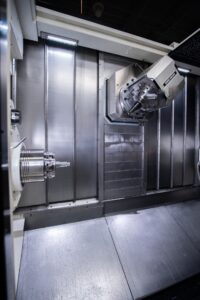Advantages of 5-Axis Machining
 One of the type of CNC equipment that is growing in application is five axis machines. These types of machines are ideally suited for producing complex shapes and sizes of machined components, in many different materials. There is a demand in all phases of the aerospace markets for tighter tolerance and better finishes. The advantages of 5-axis machines is there designed to address the tolerance, finish, fewer setup challenges.
One of the type of CNC equipment that is growing in application is five axis machines. These types of machines are ideally suited for producing complex shapes and sizes of machined components, in many different materials. There is a demand in all phases of the aerospace markets for tighter tolerance and better finishes. The advantages of 5-axis machines is there designed to address the tolerance, finish, fewer setup challenges.
There have been advances in control, servo, and tooling technology, which enhance the abilities for producing complex 5-axis machined shapes. Because of the inherent advantages of 5 axis (less chucking, less setups, reducing tolerance stack-up), they can now produce very complex shapes in a single setup.
Definition of 5-Axis Machining
Traditional CNC machines move in two linear axes (X and Z) for lathes and three linear axes (X, Y, and Z) for machining center. The term “5-axis” refers to the number of directions in which the cutting tool can move. On a 5-axis machine, the cutting tool moves across the X, Y, and Z linear axes as well as rotates on the A and B axes to approach the workpiece from any direction.
The ability to produce complex shapes without having to move the part across multiple machines offers significant advantages over previous conventional three-axis machining.
The benefits of 5-axis CNC machining are as follows:
Improved Tool Life
Improved tool life and cycle time are a result of being able to program the tool and/or table which enables the machine to maintain optimum cutting position and constant chip load.
Complex Shapes
The major (and most well-known) advantage of 5-axis machining is its ability to machine complex shapes, while minimizing the number of chucking or fixturing positions. The additional movement creates machining angles and arcs for the cutting tool and for chip relief that were only previously possible with a multitude of special fixtures or additional setups.
Fewer Setups
Five-axis machines can machine nearly every visible surface, excluding the bottom or clamping area. This ability significantly reduces the need for multiple setups and special fixtures. Depending on the workpiece and machne configuration, you can reduce the number of setups to one.
Relational Accuracy
Tolerance stack up (imprecision) is one of the results and challenges every time you have to move the part for re-chuck of fixture. Once a part comes out of the machine, precise alignment is lost. By using the same zero or home location, feature-to-feature accuracy is improved.
3+2 Axis Machining
There are parts that can only be successfully machined using full 5-axis simultaneous movement, but not all parts require the simultaneous 5-axis movement. Some parts require five axes, but not simultaneously. You can have machines with three + two axes.
In three + two machining, the fourth and fifth axes are used to locate the workpiece (or cutting tool, depending on the type of machine) in a fixed position. In these scenarios, there is no need for all five axes to move simultaneously.
The same tool paths can be achieved in a three-axis machine, but only after loading and unloading between multiple setups, fixtures, or machines. The 5-axis machine increases uptime, decreases human error, and eliminates the need for special fixtures. For parts with features or holes on multiple faces or angles, three + two machining is the clear choice.
Better Surface Finish
Using the rotating fourth and fifth axes, the part can be orientated to bring it closer to the cutting tool. If the part can get closer to the cutting tool, then the cutting tool can be shorter. A shorter cutting tool is less susceptible to vibration at higher cutting speeds, which directly impacts surface finish.
As technology advances, so do the market expectations for higher quality products. Offering competitive pricing is a given. To meet this challenge, Intrex has made significant investments in full 5-axis and three + two axis equipment. We also have made significant investments in systems software to oversee and control our entire manufacturing process.
We would welcome an opportunity to speak to you about addressing your supply chain needs. Contact Intrex today.
